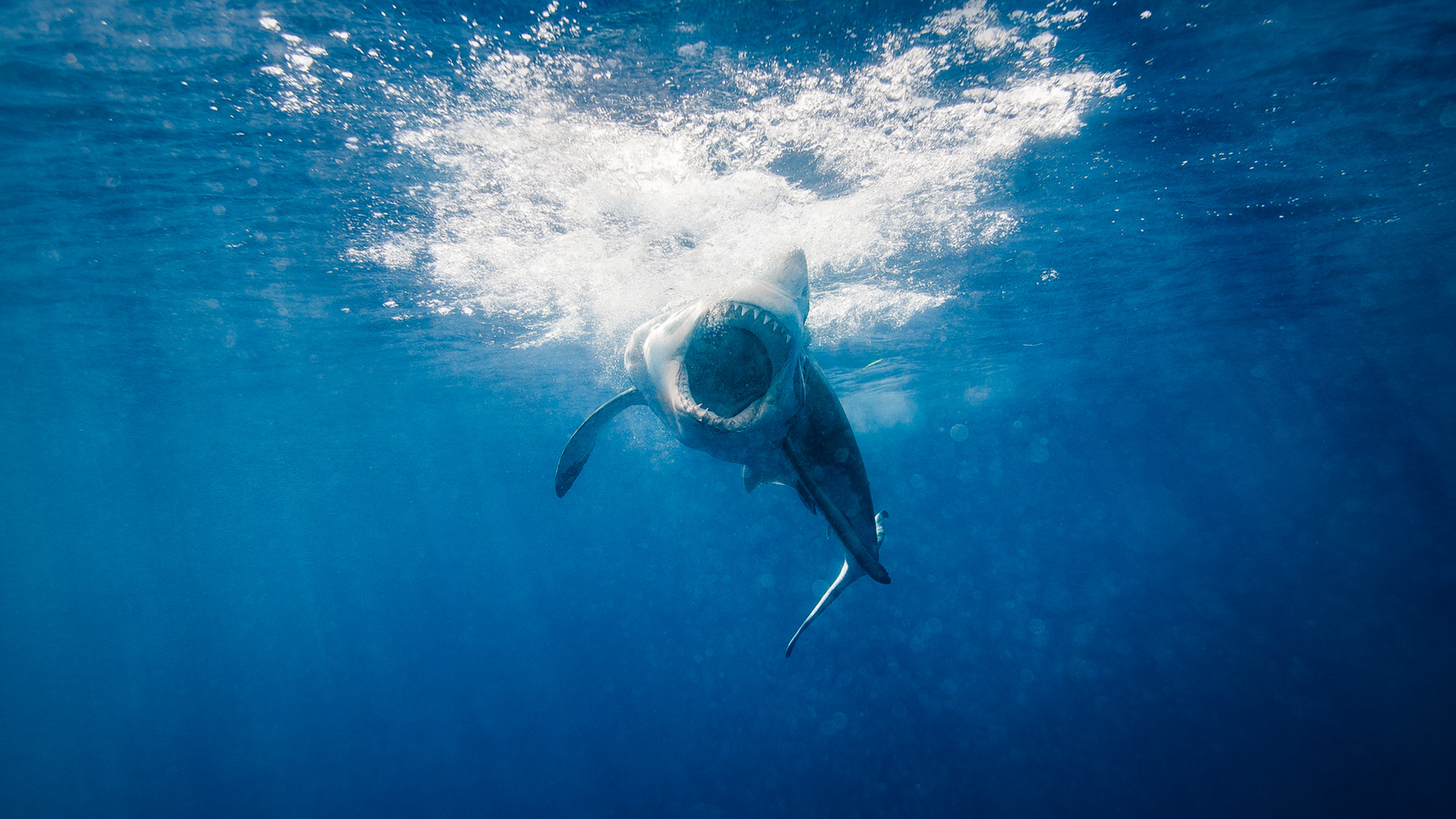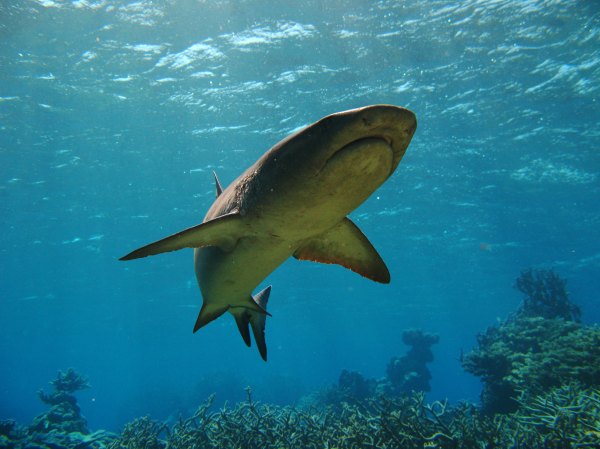We may earn revenue from the products available on this page and participate in affiliate programs. Learn More ›
The first fatal great white shark attack of 2023 took place only five days into the new year. On Jan. 5, a 50-year-old fisherman went diving for scallops in the Gulf of California off the coast of Mexico. He was swimming along the seafloor collecting shellfish when a great white shark bit down around his shoulders and decapitated him.
With real-life stories like these, it’s easy to see why great white sharks have such a fearsome reputation. They’re one of the most powerful hunters in the ocean, after all. And if you were to look at the list of shark attacks that have taken place globally over the last 400-plus years, you’d see that great white sharks are responsible for more attacks on humans (both fatal and nonfatal) than any other shark species.
Still, 351 documented attacks in 443 years doesn’t seem like much when you consider the number of people who regularly swim in waters inhabited by great whites. Not to mention the fact that dogs kill far more people every year than great whites do. Between 30 and 50 people die from dog bites each year in the U.S. alone, according to the National Library of Medicine. By comparison, sharks killed nine people around the world in 2022 — and that includes all species of sharks. (At least two of those deaths were believed to be caused by great whites.)
The fact is: Great white shark attacks are rare. But that doesn’t make these marine killing machines any less terrifying. Let’s take a closer look at the facts around great white shark attacks, including how and why they occasionally attack humans.
Table of Contents
Great White Shark Attacks by the Numbers
How Great White Sharks Hunt and Attack Their Prey
Why Do Great White Sharks Attack Humans?
Do Great White Sharks Eat Humans?
Support for the “Mistaken Identity” Theory
Great White Shark Attack FAQS
Great White Shark Attacks by the Numbers
The University of Florida has been studying shark attacks around the world for more than 60 years. These investigations span from the present day to the late 16th century, and the results have been combined into the ultimate resource for shark attack statistics, known as the International Shark Attack File. Importantly, these figures only include “unprovoked” shark attacks or bites — as opposed to “provoked” incidents that are initiated by humans (feeding, harassing, or unhooking a great white shark caught from the beach, for example).

Infographic via International Shark Attack File
Here are those numbers at a glance:
- Since 1580, there have been 949 unprovoked shark attacks documented around the world
- 351, or 37 percent of those, involved great white sharks; of those attacks, 59 were fatal
- Tiger sharks have been linked to 142 attacks over that same period of time, while bull sharks have been linked to 119 attacks
ISAF curators emphasize that these numbers should be taken with a grain of salt because attacking sharks are sometimes misidentified by victims and bystanders. Still, bull sharks, tiger sharks, and great white sharks are considered “The Big Three” because they are more than capable of inflicting serious injury, and they often hunt in areas frequented by humans. These three species account for roughly 65 percent of shark attacks around the world and are the most likely suspects when an attack occurs.
How Great White Sharks Hunt and Attack Their Prey
Growing up to 20 feet long and topping out at more than 6,000 pounds, great white sharks are the largest predatory fish on the planet. They have only two natural predators: humans and killer whales. Orcas hunt great white sharks, but they only succeed in taking down the apex predators by teaming up on them. As shown in a recent video, a pod of whales will work together to herd a great white to the surface, where they bite into the shark and feast on its organs.
Great white sharks, however, are solitary predators. They rely primarily on their noses, ears, and ultra-sensitive mouths to hunt. Their ears are tuned to pick up on the low-frequency sounds of struggling critters, and they can smell blood in the water from up to three miles away. Great whites then use tiny sensory organs around their mouths to home in on their prey. Known as ampullae of Lorenzini, these organs function like lateral lines in other fish species, detecting changes in electromagnetic fields and helping them track their prey with precision. Research shows they can detect the impulses given off by an accelerated heartbeat, which means they can literally sense fear.

Photograph by Uryadnikov Sergey / Adobe stock
Great white sharks also use their eyes when hunting, but their eyesight isn’t quite as strong as their other senses, which can sometimes lead to cases of mistaken identity. (More on this below.) They do a lot of their hunting in shallower waters near the coastlines. This is for a couple reasons: It’s where many of their favorite prey sources congregate, and it’s easier to ambush prey there.
When these sleek torpedoes move in for the kill, they use their speed and sheer power to blindside their prey, typically attacking from below. Great whites will, at times, launch completely out of the water as they bite down with tremendous force, using their hundreds of razor-sharp teeth to tear into their prey.
Not all bites are this savage, though. Like many shark species, great whites also use their mouths to explore their environment and investigate unfamiliar objects — similar to how we use our own hands — and their taste buds help them identify whether the object is edible or not. This helps explain why attacking great white sharks don’t always kill people even though they’re more than capable of doing so with a single bite.
“Everyone wants to think sharks just search out seals, but they bite a lot of things that don’t resemble any of their known prey,” shark expert and author A. Peter Klimley explained to National Geographic years ago. “They don’t tear these things to pieces. They take a bite, feel them over, then move on.”
Why Do Great White Sharks Attack Humans?
It’s widely understood that great white sharks don’t consider humans to be food since we’re not part of the marine ecosystem. We’re also much bonier and offer far fewer calories compared to their all-time favorite prey: seals and other marine mammals, which are covered in thick layers of fat. So, why would a great white shark go out of its way to attack a human in the first place?

Photograph by willyam / Adobe stock
Klimley’s line of thinking touches on one potential explanation: curiosity. Because they’re at the tip-top of the food chain, great whites aren’t afraid to use their mouths to check out something that looks vulnerable, such as a buoy, a kayak, or a boogie boarder.
The other predominant theory is that most great white shark attacks on humans are cases of mistaken identity. A shark senses a person in the water, thinks they’re a seal or another marine mammal, and chomps down on them. Sometimes these initial bites are severe (or ill-placed) enough to make a person bleed out and die. But most of the time, the shark tastes its mistake and swims away from the person.
Do Great White Sharks Eat Humans?
It’s hard to find any confirmed reports of a great white shark actually eating a human after an attack, although in some rare cases, the victim’s body is never recovered. The closest shred of evidence supporting this possibility dates back more than 100 years.
Peter Benchley, who wrote the novel that inspired the classic movie Jaws, has said in past interviews that the bloodthirsty great white shark at the center of the story was pure fiction. But in one introduction to his book, Benchley alludes to the “Matawan Man-Eater,” which reportedly attacked five people, killing four, along the Jersey Shore during the summer of 1916.
Read Next: Great White Shark Tales from Cape Cod’s Charter Boat Captains
The attacks set off mass hysteria that even caught the attention of then-president Woodrow Wilson. They also fueled a shark-killing frenzy that July, and several local fishermen caught and killed sharks in the area that they claimed were the man-eater. This included other species besides great whites, including bull sharks, and there’s still some debate as to what species the man-eater was — or whether there were multiple sharks involved. Some experts still lean toward a bull shark because two of the attacks occurred in fresh- or brackish water along Matawan Creek, and bull sharks can tolerate freshwater while great whites cannot.
Regardless, one of the people who claimed to have killed the Matawan Man-Eater was a taxidermist from New York, who killed a 7.5-foot great white while fishing in Raritan Bay. The shark allegedly attacked his rowboat and he killed it with his oar. When the taxidermist cut open the shark’s belly, he found part of a leg bone and other human remains inside, according to the author of Twelve Days of Terror.
Support for the “Mistaken Identity” Theory
More recently, in 2007, an Australian scuba diver claimed he was swallowed head-first by a great white that tried to eat him alive. (He said he survived by punching and gouging the shark’s eye socket while inside its gullet.) Just like the Mexican diver who was killed by a great white in January, the Aussie diver was collecting shellfish along the seafloor when he was attacked in 2007.
This commonality between the two attacks reinforces the “mistaken identity” theory. Referring to the recent attack in Mexico, one expert told LiveScience that the fishy smell around the diver and the vibrations caused by prying shellfish off the seafloor “could have lured the shark” to the area.
“It is also possible that [due to his position on the seafloor] he resembled a sea lion foraging,” another expert said.

Photograph by Brett Monroe Garner / Getty
A 2017 paper out of Stanford University found that the highest risk group for great white shark attacks in California is surfers. And judging by the attacks that have occurred in other places around the world, the same could be said for surfers in other great white hotspots, such as South Africa and Western Australia. This adds up, since surfers typically wear dark-colored neoprene wetsuits that can resemble the sleek hide of a seal when they’re splashing, diving, and shredding in the waves.
A separate 2021 study that took a “shark’s-eye view” of humans swimming and paddling surfboards drew the same connection between surfers and seals. Its authors concluded that it’s impossible for a great white shark to unequivocally tell a pinniped from a human paddling a surfboard.
But out of all the studies that have looked at great white shark attacks — and there are many — one of the most revealing was published earlier this year. In the study, published in PLOS ONE, researchers at California State University, Long Beach, flew drones over 26 beaches in southern California one day a month for two years. As they surveyed the nearshore waters, they looked at where people and great white sharks were swimming in close proximity to each other.
The researchers found that the vast majority (91 percent) of these 1,204 “human-shark-co-occurrences” were at two locations in particular: Carpinteria Beach and Del Mar Beach. They saw great whites swimming close to humans on 97 percent of the days they flew their drone over the two beaches. They also noted that surfers and paddle boarders were the people most likely to find themselves near great white sharks because they often ventured beyond the wave break.
During this same stretch of time, there was only one unconfirmed report of a shark bite along the two beaches, one of the study’s co-authors Chris Lowe told LiveScience.
“This study provides evidence that high human-shark spatio-temporal overlap does not lead to an increased bite frequency in southern California,” the authors write, “and there are a number of possible explanations as to why [juvenile great white sharks] are not biting water users despite daily encounters.”
In other words, people swim near great white sharks nearly every day. But it seems we’re far more interested in them than they are in us.
Great White Shark Attacks FAQS
Yes, great white sharks will attack and kill other shark species. They’ll also cannibalize their own kind. There is plenty of evidence of great whites actively hunting and killing other, smaller shark species. Researchers in South Africa looked into this and were surprised to find that in one particular location, other sharks made up a larger portion of a great white’s diet than seals did.
Great white sharks inhabit nearly all of the world’s major oceans, but some of the highest concentrations of sharks are in southern California and the waters around Cape Cod, along with the Australian and South African coasts. Beaches in Western Australia are hotspots for great white shark attacks, and it’s one of the only places that employs shark nets and other preventative strategies to help keep beachgoers safe.
The U.S. records the highest number of shark attacks every year, according to the International Shark Attack File, with the highest number of attacks occurring in Florida. The vast majority of these attacks are nonfatal, however, and they typically involve bull sharks, tiger sharks, and other species besides great whites.
Final Thoughts

Photograph by Matthew Micah Wright / Getty
Great white shark attacks on humans are rare, especially when you consider that people swim in waters inhabited by great whites nearly every day. When these attacks do happen, however, they can be grisly and sometimes deadly. Most experts have theorized that great white sharks attack humans out of curiosity or due to cases of mistaken identity. One recent study found that most of the time, even when humans are easy prey, great white sharks want nothing to do with us.

















